Keyword Difficulty is an SEO metric that quantifies how competitive a given keyword is and estimates how hard it is to rank on the first page of Google. The higher the KD score, the harder it is to rank for a particular search query.
The question is, how do these keyword research tools measure keyword difficulty? Is the calculation even accurate and reliable? Do Keyword Difficulty scores really matter? This article aims to answer all of these big questions.
How the Top Tools Calculate KD
Marketers don’t have any other choice but to blindly rely on their chosen keyword difficulty software, trusting that the results are reasonably accurate. But it also helps to understand how these top tools calculate keyword difficulty because apparently, they seem to follow different formulas.
1. Keywords Everywhere
Many keyword tool owners would consider their keyword metric calculations confidential, but Keywords Everywhere is 100% transparent on how we calculate all of our metrics and provide an updated and detailed breakdown for each.
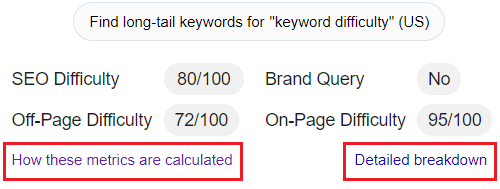
In terms of Keyword Difficulty, Keywords Everywhere shows four main data points:
- SEO Difficulty: This is the general keyword difficulty metric gauging how difficult it is to rank at the top positions for a given keyword. The higher the SEO difficulty score, the more difficult it would be to rank. The exact formula is as follows:
SEO Difficulty =(35% of On-Page Difficulty + 65% of Off-Page Difficulty) + 20% bonus for branded queries
- Brand Query: Branded keywords are very specific search intent and are generally tough to rank (unless you are the brand), so we factor this in when calculating keyword difficulty.
- Off-Page Difficulty: The backlink equity of the ranking pages matters a lot. Thus, we gave 65% weight to this parameter. If the off-page difficulty score is high, that means you need to match or exceed the competing site’s backlink profile to stand a chance.
We measure the off-page difficulty based on the Moz Domain Authority and the Open Page Rank score.
The exact formulation is as follows:
Off-Page SEO Difficulty =75 % of ( Moz DA ) + 25% of ( OPR *10 )
- On-Page Difficulty: We designated 35% weight to the quality of the ranking pages’ on-page SEO.
We use the following set of rules when coming up with the on-page SEO score:

If you click “Detailed Breakdown”, you can instantly see the summary of these metrics across the top 10 ranking pages. This way, you can more easily scan and measure the keyword difficulty and perceived value of the competitors’ content. Depending on your site’s domain authority, you’re free to open each of the ranking pages and manually check if you can come up with something better, more detailed, and more valuable.
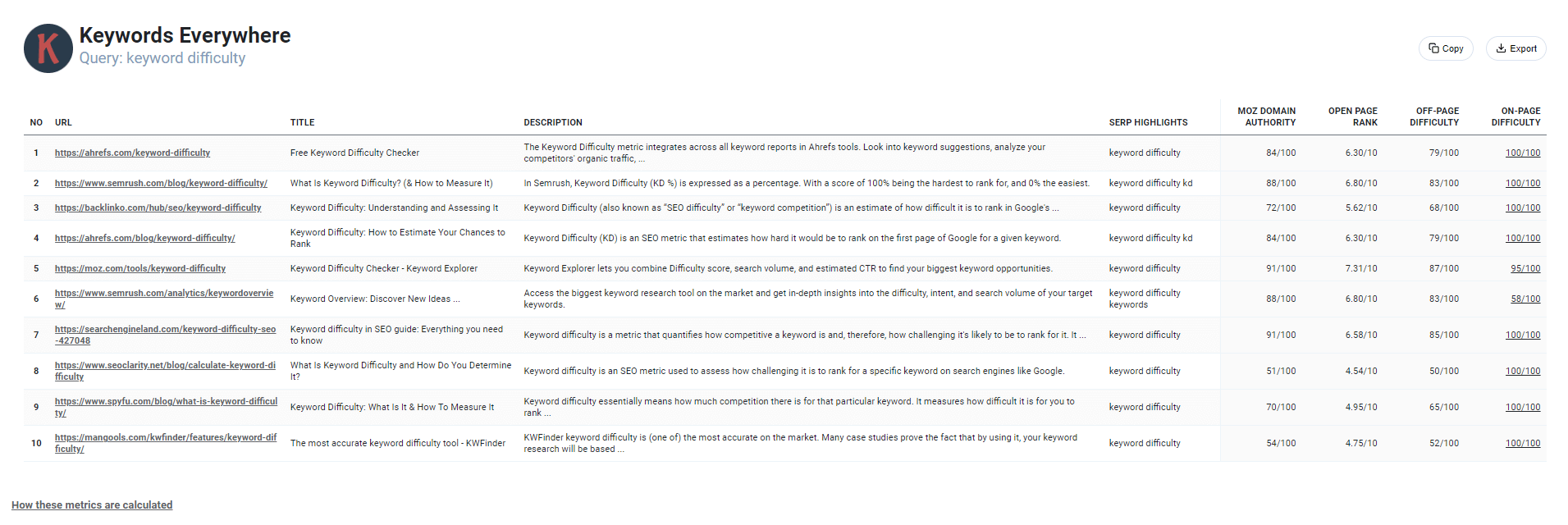
2. Semrush
Semrush published an article in 2021, detailing how they have updated and enhanced their keyword difficulty tool. They explain how they come up with their Keyword Difficulty metric in three steps:
Step 1: Analyze the SERP
Semrush checks the 10 pages ranking on the first page of Google and gauges their overall strength, particularly the number of referring domains pointing to each page, the overall Authority Score, and the follow/nofollow link ratio.
Step 2: Check the search volume
Semrush then checks the given keyword’s search volume and checks whether it’s branded or not. It continues to check other characteristics like the ranking pages’ word count and SERP features. Semrush assigns different weights across these parameters based on how much they’re likely to impact the difficulty of ranking on the first page. The list of parameters along with their corresponding weight shares is outlined below:
| Parameter | Weight Share |
| Median # of referring domains for ranking URLs | 41.22% |
| Median Authority Score for ranking domains | 16.99% |
| Search volume | 9.47% |
| Median follow/no-follow ratio for ranking URLs | 9.17% |
| Featured snippet | 4.74% |
| Instant answer | 4.07% |
| Branded keyword | 3.50% |
| Local pack | 3.39% |
| Knowledge panel | 2.71% |
| Top stories | 2.03% |
| People also ask | 1.36% |
| Site links | 1.36% |
| Word count in keyword | -2.24% |
| No SERP features | -8.59% |
Step 3: Weighing everything by country.
Semrush also weighs the score based on the regional database it’s in to avoid outliers, especially in less populated countries.
Semrush hasn’t published another detailed update since 2021, so it’s safe to assume that they could still be using the formulation above to come up with their Keyword Difficulty scoring.
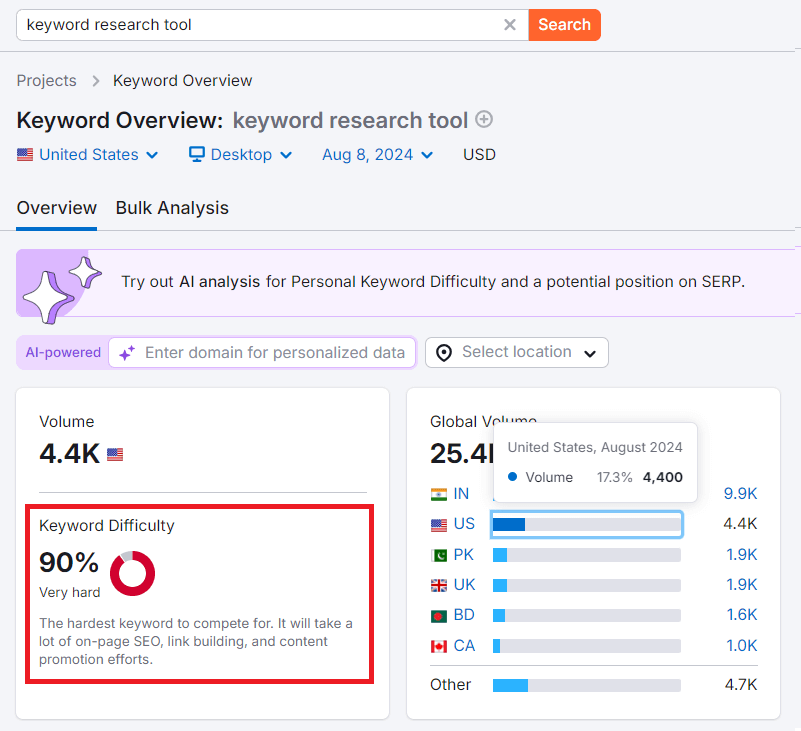
As you can see, Semrush ‘s keyword difficulty checker also sets categories to easily indicate the Keyword Difficulty– from ‘Very Easy’ to ‘Very Hard’. They’ve also added a new metric called Personal Keyword Difficulty (PKD) which measures how hard it is for your specific domain to rank in the top 10 for a given keyword.
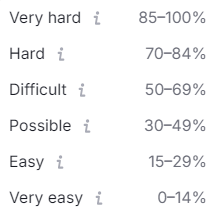
3. Ahrefs
Ahrefs has been very popular, especially as a backlink analysis tool. However, as a keyword difficulty checker tool, it seems that Ahrefs is only relying on the number of referring domains and does not use any other metric to calculate KD. That’s why you may have noticed how Ahrefs shows a score of 0 in lots of high-volume keywords like smoothies near me, coffee shops near me, home goods near me, and data analyst salary.
In bigger countries like the US, this skewed data might be less evident since the competitors’ backlink profiles are generally larger, but in smaller countries or databases, these abnormalities become more apparent.
Although a site’s backlink profile is a strong indicator of competitiveness, it’s not the only measure of actual difficulty since other metrics like search volume and intent matter as well.
If you’re a strong domain, Ahrefs’ KD metric might not matter that much, but for those sites who are yet to establish their backlink profile and overall domain authority, Ahrefs’ difficulty checker might not provide the most accurate insights you need.
4. Moz
Moz is one of the big players in the world of SEO tools, particularly because of how it offers a straightforward way of measuring domain strengths and guiding SEO strategies. But when it comes to checking keyword difficulty, it also shows strong signs of dependence on a domain’s Authority Score.
Like Ahrefs, this reliance on a single parameter can lead to deviations, especially in smaller databases. For example, when compared to tools that factor in more parameters, Moz shows a significantly low KD for the following selection of highly competitive keywords.
| Keyword (US) | keywordseverywhere_KD | semrush_KD | moz_KD |
| chiefs | 84 | 95 | 50 |
| bears | 91 | 86 | 46 |
| dodgers | 95 | 99 | 57 |
| patriots | 85 | 97 | 56 |
| trump news | 81 | 86 | 56 |
| american airlines | 91 | 95 | 60 |
| google hangouts | 95 | 100 | 68 |
Other Ways to Gauge KD
Keyword research tools definitely streamline the process of determining keyword difficulty. However, in the end, nobody really knows what exactly Google does to rank content and keywords. Third-party software tools can only try to figure it out. It’s best to turn to these resources as a tool for guidance at best. Since 100% accuracy in terms of KD metrics can be hard to come by, you can also consider keyword difficulty scores as ‘relative’ to help you pick which search terms to prioritize in your content marketing campaigns.
You can also try to gauge keyword difficulty by checking the SERP itself. This process is not 100% accurate in and of itself, but it can provide a broad measure of how competitive the first-page rankings are. In general, some good signs of low KD include the presence of:
1. Forums and Q&A Threads
If you find lots of entries from Quora, Reddit, Yahoo Answers, and the like, that could be a sign that the competing sites haven’t fully covered such a topic yet. However, take this tip with a grain of salt because, since the last Google Update, these pages have gained more weight and could be harder to outrank than before.
2. Social media results
If there are lots of results coming from social media sites like Pinterest or Instagram, that could also be a good sign of a content gap.
3. Low # of high-authority sites
It helps to download helpful SEO extensions like Keywords Everywhere, so you can instantly check the domain authority and referring domains of websites as you browse Google. The lower the number of high-authority sites on page 1, the better. You can also check the referring domains
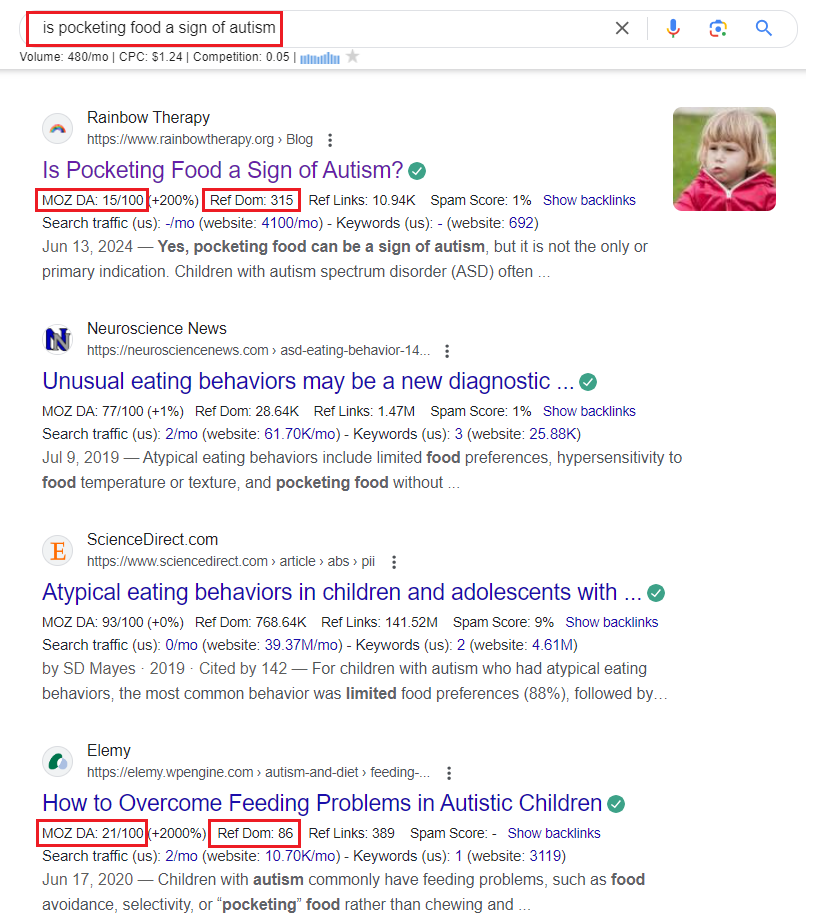
4. Underdeveloped Topic Coverage
Upon checking the top-ranking pages and scanning or doing actual content analysis, if you can sense how the ranking pages are lacking depth, length, and material, you may have a chance to beat them by simply offering more value.
Make sure to still check your seo keyword difficulty tool, but do remember that you can always throw a mix of high KD and low KD queries in your campaign. At the end of the day, Google is actively looking to show the best, most relevant, and most helpful results. If you can commit to consistently delivering value in your space, it’s only a matter of time before Google will favor your pages over the bigger players.
Keyword Difficulty vs. Competitive Density
Competitive Density is another SEO term that is often mistaken for Keyword Difficulty. Both terms refer to how difficult it is to target a given keyword. However, they’re fundamentally different in a way that:
- Keyword Difficulty (KD) measures how difficult it is to rank in organic search
- Competitive density (Com.) quantifies the difficulty of ranking through paid search
It helps to compare both metrics to better estimate if the keyword would be a feasible target in your paid and organic marketing efforts. If you want to focus on gaining more organic traffic through content marketing, focus on the Keyword Difficulty or SEO Difficulty metrics.
How to Use Keyword Difficulty
Here are other tips for leveraging KD insights and making your SEO strategy more efficient and effective:
1. Examine other metrics besides KD
Keep in mind that Keyword Difficulty is not the be-all and end-all of SEO. However, it’s a crucial piece of information that can guide your SEO strategy. Make sure to also check the following side by side with the keyword difficulty:
- Search Volume: Even if a search term has very low Keyword Difficulty, if it doesn’t have search demand, it won’t count for much. Consider the search volume as well to ensure that you’re making the most of your SEO budget.
- The keyword’s business value: Even if the keyword has the ideal KD score and search volume, if it won’t help you attract business and drive conversion, your efforts and resources will just go in vain.
For example, if you’re selling shoes and you target too many keywords related to socks, it won’t make much sense. If you want to rank highly for a certain keyword, it should ideally be directly related to the product or service you’re selling. In essence, a keyword has a good conversion potential if the people searching for content are not only looking to read and learn but are also looking to buy or take action.
2. Prioritize efforts and resources towards low KD
Not only is it potentially easier and faster to catapult low KD keywords to the top of SERPs, but it’s also more cost-effective if you’re doing paid search ads. Low KD keywords have a lower cost per click. Plus, they are more likely to be niche keywords that have more specific search intent– which could lead to better engagement and conversions.
3. Balance high KD terms with attainable ones
While it’s ideal to optimize your content strategy based on lower key difficulty, it also wouldn’t hurt to balance your approach to diversify traffic sources and establish a more strategic positioning.
For example, you can try to aim for high-volume, high KD keywords with great business potential and just invest more time and resources for outstanding content creation for these terms. You can go long-form and add infographics and other elements to add more value to these competitive queries. For the rest of your posts, you can focus on regular response posts and moderate effort but with a focus on consistency. Feel free to adjust your approach according to the results you generate and the insights you gather.
4. Strategic link building
High KD search terms are typically targeted by sites with strong backlink profiles. You can try building backlinks around your low KD keywords since fewer sites are vying for those queries, and they could be easier to optimize in terms of link equity. It could take less resources to start seeing results around these keywords.
5. Track keyword performance
It’s crucial to constantly evaluate the effectiveness of your SEO strategy. Identify your high-performing keywords and check if there are trends or insights that you can adopt to further refine your keyword targeting approach. With this insight, you can also optimize your SEO budget and invest more in areas and activities that generate the best results.
Conclusion
Make the most of keyword research tools to identify the best keywords for your campaign. Whether you’re looking for quicker wins or long-term success, keyword research is a foundational step in your SEO campaign.
Watch out for the most relevant metrics that drive business growth and keep informed about the latest industry news to stay on top in the competitive digital space.


